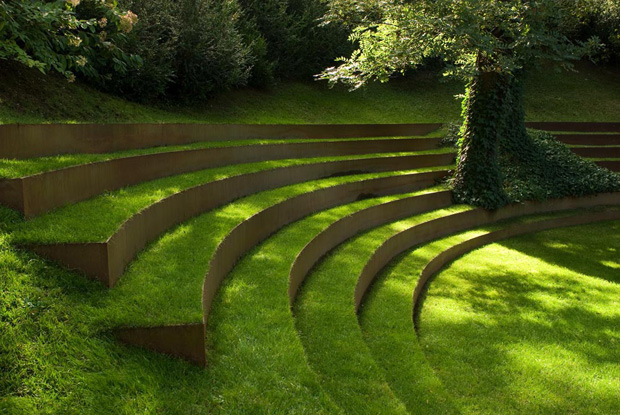
AMPHITHEATER
An amphitheatre (British English) or amphitheater (American English; both /ˈæmfɪˌθiːətər/) is an open-air venue used for entertainment, performances, and sports. The term derives from the ancient Greek ἀμφιθέατρον (amphitheatron),[3] from ἀμφί (amphi), meaning "on both sides" or "around" and θέατρον (théātron), meaning "place for viewing".
Ancient Roman amphitheatres were oval or circular in plan, with seating tiers that surrounded the central performance area, like a modern open-air stadium. In contrast both ancient Greek and ancient Roman theatres were built in a semicircle, with tiered seating rising on one side of the performance area.
Modern parlance uses "amphitheatre" for any structure with sloping seating, including theatre-style stages with spectator seating on only one side, theatres in the round, and stadia. They can be indoor or outdoor.
Natural formations of similar shape are sometimes known as natural amphitheatres.
while it is true that facilities which physically allowed it were used to accommodate performances commonly reserved for other building types.
Ancient Roman amphitheatres were major public venues, circular or oval in plan, with perimeter seating tiers. They were used for events such as gladiator combats, chariot races,[dubious – discuss] venationes (animal hunts) and executions. About 230 Roman amphitheatres have been found across the area of the Roman Empire. Their typical shape, functions and name distinguish them from Roman theatres, which are more or less semicircular in shape; from the circuses (similar to hippodromes) whose much longer circuits were designed mainly for horse or chariot racing events; and from the smaller stadia, which were primarily designed for athletics and footraces
The earliest Roman amphitheatres date from the middle of the first century BCE, but most were built under Imperial rule, from the Augustan period (27 BCE–14 CE) onwards
Imperial amphitheatres were built throughout the Roman empire; the largest could accommodate 40,000–60,000 spectators. The most elaborate featured multi-storeyed, arcaded façades and were elaborately decorated with marble, stucco and statuary. The best-known ancient amphitheatre is the Colosseum in Rome, which is more correctly termed the Flavian amphitheatre (Amphitheatrum Flavium), after the Flavian dynasty who had it built.[citation needed] After the end of gladiatorial games in the 5th century and of staged animal hunts in the 6th, most amphitheatres fell into disrepair. Their materials were mined or recycled. Some were razed, and others were converted into fortifications. A few continued as convenient open meeting places; in some of these, churches were sited.
